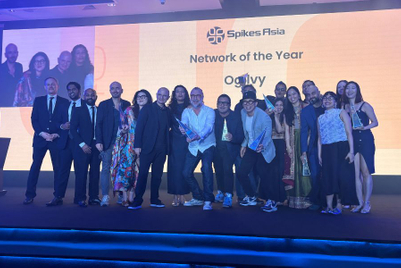
The China American Football League (CAFL), which plans to kick off its debut season in the fall of 2015, marks the first commercially backed professional sports league in China, according to Gary R. Morris, CEO of the CAFL. This is a big step, Morris explained, because all the others in the country, including the highly successful basketball league, are state-owned enterprises at their core.
League chairman Martin Judge, who also shares ownership of the US Arena Football League’s Philadelphia Soul, founded the CAFL. He and Morris started laying the groundwork about three years ago. While Morris resides largely in Shanghai and Judge in the US, league headquarters are in Beijing.
To support the launch on the US side of the Pacific, the league has retained Ari Fleischer Sports Communications, the PR agency headed by the former Bush-administration press secretary of the same name. Fleischer told Campaign the CAFL is talking to large American brands as well as large Chinese and Asian brands, covering a variety of segments, including banks, restaurants and more-traditional sports equipment makers. Morris also hinted at possible auto and beverage company sponsorships.
“There are some familiar suspects here in the United States,” Flesicher said. "A lot of successful corporations doing business for many years in China also understand football.”
A Spalding banner on the CAFL home page hints broadly at one sponsor, although Morris said a relationship with the sports equipment giant, based in Bowling Green, Kentucky, is not yet official.
As for bringing Chinese brands into the football fold, Fleischer acknowledged a learning curve about the American sport. However, he said, a number of factors add momentum: “Having the sponsorship of the Chinese government is a game-changer in China.”
 Morris also implied that the relationship with China's sports ministry is close and the government body is ready to do what it takes to support the CAFL. He did not indicate a financial relationship but did suggest great logistical assurances to help the league succeed. As the first commercially backed sports venture, it could become a blueprint for the future if successful.
Morris also implied that the relationship with China's sports ministry is close and the government body is ready to do what it takes to support the CAFL. He did not indicate a financial relationship but did suggest great logistical assurances to help the league succeed. As the first commercially backed sports venture, it could become a blueprint for the future if successful.
Every major city in the country has large sports arenas and the football games to be held in them are an opportunity to bring content to the venues as well as create jobs and leisure opportunities for local residents. At least for the time being you will not see any of the wrangling over arena funding that so often ties up team deals in American sports. The venues are all there waiting to be used.
What’s more, Fleischer explained, “Sports is ancient to China, and the Chinese take tremendous pride in their competitions. Chinese companies might not know how to run a screen pass but they understand the revenue potential for a new competitive league.”
“It’s exciting to see how a new market can be tapped for a wonderful old American sport,” Fleischer said.

A Beijing arena hosted a recent arena-football exhibition game.
Building a franchise
Privately owned professional teams will debut next year, the CAFL’s Morris told Campaign, representing six to eight first-tier cities including Shanghai, Guangzhou and Beijing. Players will comprise a 50/50 mix of foreign and local talent. Each team will handle its own marketing; ownership of individual teams (still under negotiation) will probably be a mix of corporations and individuals.
While Morris declined to specify TV deals in the works for CAFL, he said the league has been in discussions with one well-known, sports-only network. "You might be able to guess which one that is,” he said. Promotional plans for 2015 include extensive social media as well as TV advertising.
Fleischer said the league is taking a deliberate approach to building interest in CAFL football on Chinese social media such as Weibo. “When you look at other sports in China, tennis for example, social media is massive,” he said. “It’s too soon for that to happen for Chinese football — it won’t develop personalities and relationships with players” until team lineups announce in winter and spring of 2015.
Since local climate and the ready availability of sports facilities, as well as pollution concerns, guided the Chinese Sports Ministry and the CAFL to adopt an arena-football approach, some talent for Chinese teams will come from the AFL league in the US. Some former NFL players or college players who aren’t picked up by the NFL are also likely to join, Morris said. Universities where the CAFL is already supporting games (Tianjin, Hebei, Wuhan, Xi'an, Shenyang and Shandong) will be the main source for local talent.

Chinese university teams are fielding teams that should provide the league with a talent pool.
The CAFL wants to build the same kind of feeder system US colleges provide to professional teams, so this year the CAFL has been supporting games at Chinese universities. Local rugby leagues will also be a source for talent. Referees will likely all be foreign at the start, but Morris emphasised the aim is to shift to an entirely home-grown talent pool for all aspects of the game.
Morris also enthused that the game’s closeness to fans was also a factor for the government choosing to endorse arena-style football. “Fans sit right along the court walls (it’s like a hockey rink), and can see the players’ eyes. Game balls will also fly off into the crowd and fans can keep those. And with the music and lights, the whole thing becomes a very exciting event.” Morris said crowd engagement at an exhibition game the league held earlier in the year in Beijing in front of 10,000 spectators closely resembled the intensity of basketball league games in China.
While transplanting a rough and very American style sport may seem like an uphill battle, Morris said he is optimistic. He sees great enthusiasm from players, both local and foreign, and believes relationships are strong and all the necessary support is in place. Now it's just a matter of getting the fans to come around. And that's where the marketing starts.
Morris said the CAFL would begin its campaign to build public demand in early 2015. Campaign Asia-Pacific contacted some sports-marketing firms in China and the APAC region but none had yet heard of the league.
Fleischer said the CAFL has also been in close contact with the NFL about the commercial prospects of transforming American football into a truly international sport. “While this is not a carbon copy of the NFL, anywhere American football goes is good for everyone.”
Fleischer added that CAFL founder Judge is already considering other Asian countries likely to embrace the sport. “Marty’s very optimistic about the future,” Fleischer said.

The league has received coverage in China Daily.


.jpg&h=334&w=500&q=100&v=20250320&c=1)

+(1).jpg&h=334&w=500&q=100&v=20250320&c=1)
.jpg&h=334&w=500&q=100&v=20250320&c=1)

.jpg&h=334&w=500&q=100&v=20250320&c=1)

.jpeg&h=334&w=500&q=100&v=20250320&c=1)
.jpg&h=334&w=500&q=100&v=20250320&c=1)








